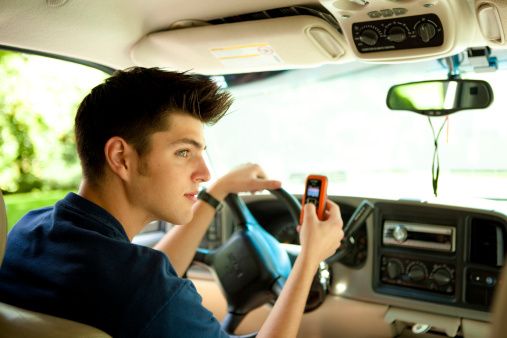Teenage drivers are likely to take their eyes off the road to send and receive text messages – even in states where it is against the law because of the likelihood it can cause catastrophic distracted driving crashes, a hidden camera shows.
In working on a story about the dangers of texting and driving, CBS 6 News of Richmond, Virginia, obtained permission from a parent to place a hidden camera in her son’s car to monitor his behavior when he drove to school and work.
The captured footage shows the 17-year-old keeping his eyes on the road most of the time. However, it also catches him looking down – apparently on the phone – while the vehicle is moving and also at a stoplight. Confronted with the evidence, the teenager admits breaking that state’s texting-while-driving law.
The teen explains that technology is “built into” his generation to the point that teens constantly use the phone – whether on Instagram or Twitter or by texting and talking.
However, after watching the footage and hearing the story of a woman whose husband was killed by a texting driver, the teen and his mother say his texting while driving days are over.
Are Teens Getting the Message about Texting?
Texting while driving is a primary offense in Virginia, meaning law enforcement officers can pull over people suspected of sending and receiving texts behind the wheel.
Florida finally recognized the growing danger of distracted driving and passed a ban on texting behind the wheel that took effect in October 2013.
Unfortunately, it is only a secondary offense in our state. This means that law enforcement officers have to catch offenders committing some other offense before they can cite them for texting while driving.
Fittingly, when Gov. Rick Scott put his signature on the distracted driving law in May 2013, he did so at a Miami high school in front of an audience of teens.
The question remains: Are teen drivers in Florida and across the country getting the message about the dangers of texting while driving?
Study Reveals Startling Facts
A study from Cohen Children’s Medical Center in 2013 estimated that 3,000 teens die and another 300,000 are injured each year across the country in crashes stemming from texting while driving, according to a Newsday report.
That makes texting more dangerous than drinking and driving, which claims the lives of about 2,700 young people and injures 282,000 more, the Centers for Disease Control and Prevention reports.
Despite these risks, researchers at Cohen found that in a survey of 88,947 teens, some 49 percent of boys and 45 percent of girls admitted to texting while driving. Also, about 24 percent of 15-year-old drivers admitted to texting behind the wheel, while 58 percent of 18-year-olds did.
The problem of texting and driving appears to be headed in the opposite direction from drinking and driving, too. Since 1991, drinking by teen drivers has dipped 54 percent, the CDC notes.
Cohen’s chief researcher told Newsday that he considers texting and driving to be a risk similar to failure to use seat belts, driving under the influence, binge drinking, using drugs and tobacco and engaging in unsafe sex.
Yet, even though drinking and driving is considered taboo, texting while driving goes largely unpunished – until it is too late and an accident has already occurred.
Only when teenage and adult drivers take distracted driving seriously will they put down their phones while behind the wheel. We need to do whatever we can in Orlando, Winter Park and across Florida to encourage our teens to simply put down their phones when behind the wheel.









